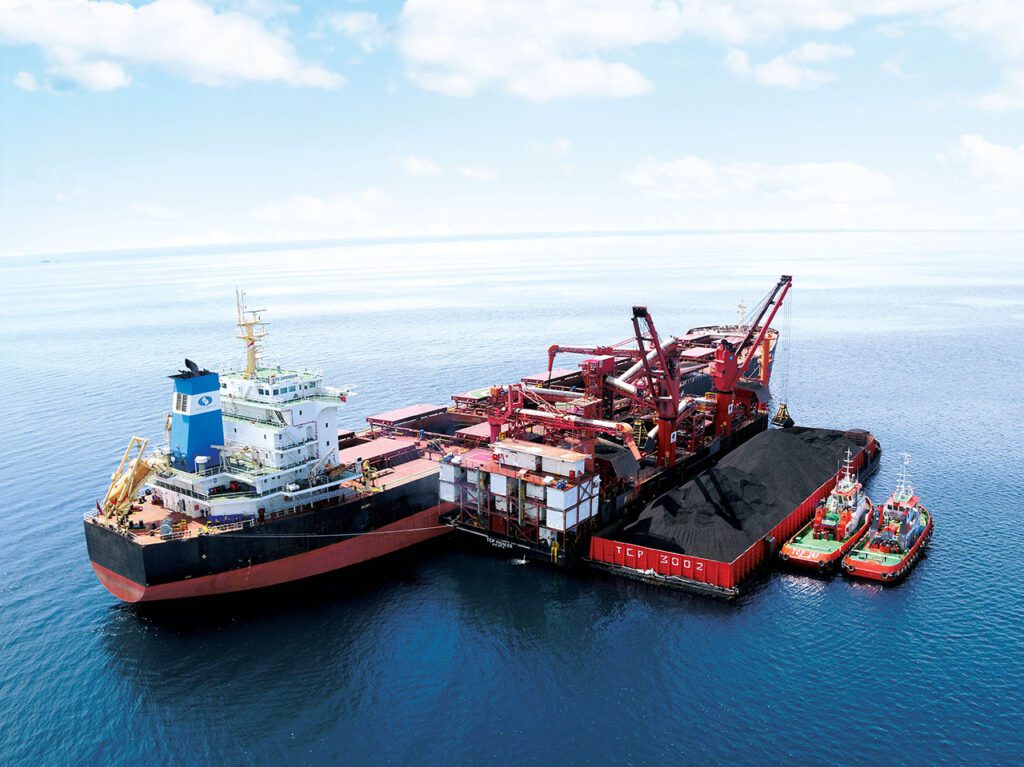Introduction
Globally, bulk coal cargo shipments by sea currently amount to over 1.2 billion tons annually. Most of this massive quantity is delivered without incident. However, there are circumstances in which it can all go dangerously wrong. This Risk Bulletin is designed to raise Member awareness of the IMSBC Code 2022 Edition mandated requirements for the safe loading and carriage of coal by sea, with a special reference to the IMO’s heightened awareness of the potential for bulk coal cargoes to liquefy and the carrying vessel to capsize.
Background
Recognition of the propensity for bulk coal to emit methane and carbon monoxide, to become corrosive and to self-heat and then ignite have existed for decades. Bulk coal cargoes have therefore been listed in the IMSBC Code as a Class MHB (Material Hazardous in Bulk) and a Group B (Chemically Hazardous) cargo for many years.
NOTE: Full details of the Group B dangers of bulk coal cargoes and the safety measures required are provided by the IMSBC Code at Section 9 and at Appendix 1, under the heading COAL.
The potential Group A properties of bulk coal have also been known for many years, but uncertainties existed. These uncertainties were investigated by the IMO’s Maritime Safety Committee. Their assessment and conclusion resulted in the amendment of the IMSBC Code 2018 Edition by IMO Res MSC.426(98) which entered into force on 1 Jan 2019.
The IMO Resolution (at Para. 50) made very important changes to the IMSBC Code designation of bulk coal as both a Group A (may liquefy if moisture exceeds Transportable Moisture Limit) and Group B (chemically hazardous). The Group A designation applies unless proved to the contrary by the cargo shipper using one of two IMSBC Code prescribed methods explained below. The Group B designation will always apply.
NOTE: Risk Bulletin No. 67, IMSBC Code 2022 Edition: More Changes for the Good, advises the IMSBC Code 2018 Edition has been replaced and it is the 2022 Edition (incorporating amendments made by Res. MSC. 500(105) ) that must now be carried on board all bulk carriers. The aforesaid amendments (which do not impact on bulk coal cargoes) will enter into force on 1 Dec 2023. All other IMSBC Code requirements, including the preceding amendments made by IMO Res MSC.426(98) (which do impact on coal bulk cargoes) continue in full force and are included in the text of the 2022 Edition.
IMSBC Code’s Upgraded Testing Requirements for Bulk Coal Cargo
As noted above, the IMSBC Code places the obligation on the cargo shipper for coal cargo testing and the pre-load provision of the results to the Master. With reference to establishing whether a bulk coal cargo is subject to Group A cargo carriage restrictions, there are two ways in which this may now be ascertained:
- Coal cargoes will not be subject to Group A restrictions and compliance if not more than 10% of its sample particle size is less than 1 mm AND not more than 50% is less than 10 mm.
NOTE: There are two important issues here:- The use of the word “AND” as this means that coal cargoes exceeding either of these particle size limits and volumes will not be exempt from Group A requirements.
- Assessing particle size and volumes requires specialist equipment and techniques. As such, it can be estimated but not determined with the requisite IMSBC Code precision by an on-site ship master and/or marine surveyor.
OBSERVATION: Reliance on coal particle size and volume determination only to assess whether a coal cargo is Group A may be unsafe if not accomplished by qualified personnel. It should only be accepted by Members and their Masters if the bulk coal sampling process has been conducted to ISO or other internationally accepted standards and the particle size and volume determination has been conducted by independent and qualified samplers and analysts.
- Alternatively, the competent authority of the country of loading can specify laboratory criteria to assess whether a bulk coal cargo possesses Group A properties. The national testing criteria should preferably be based on the results of the upgraded Proctor/Fagerberg (P/F) test methods for Group A bulk coal cargoes specified in Appendix 2 of the IMSBC Code 2022 Edition.
The upgraded test for ascertaining the Transportable Moisture Limit (TML) consists of a modified and significantly different version of the well-known P/F procedure used for testing Nickel Ore and Iron Ore Fines. The modified P/F version requires the purchase and installation of additional apparatus and the application of new techniques.
The required IMSBC Code outcome of the modified P/F test is that:
“Where moisture freely drains from the sample or the cylindrical mould at moisture content such that the test sample compaction curve does not extend to or beyond 70% saturation, the test is taken to indicate a cargo where water passes through the spaces between particles and there is no increase in pore water pressure. Therefore, the cargo is not able to liquefy.”
In brief, if a coal cargo sample drains well and the 70% saturation level cannot be reached by adding more water, then the test result means the coal cargo is not subject to liquefaction. In such a case, the coal is not classified as Group A.
NOTE: There are two important concerns here:- Whether or not the competent national authority at the port of loading does in fact require that the bulk coal cargoes must be tested in accordance with the IMSBC Code’s modified P/F TML test requirements for bulk coal?
- Whether or not the modified P/F TML test for bulk coal is currently available at the designated port of loading or within convenient proximity?
RECOMMENDATION: As a response to the above concerns, Members should be guided by the advice provided in the section below.
IMSBC Code Clarification of TML and Moisture Content Test Certification
The IMSBC Code’s Section 4., Assessment of Acceptability of Consignments for Safe Shipment, has been updated and provides important information on all bulk cargoes, inclusive of bulk coal. Members should therefore ensure full compliance with Section 4. along with all other Sections applicable to bulk coal cargoes categorised as Group A and/or Group B.
NOTE: Other essential IMSBC Code Sections relevant to Group A and/or B bulk coal cargoes include but are not limited to:
- Section 3, Safety of Personnel and Ship
- Section 5, Trimming Procedures
- Section 7, Cargoes that May Liquefy
- Section 8, Test Procedures for Cargoes that May Liquefy
- Section 9, Materials Possessing Chemical Hazards
- Appendix 1, Individual Schedules of Solid Bulk Cargoes, with reference to COAL and the latest amendments and updates.
- Appendix 2, Laboratory test procedures, associated apparatus and standards, with reference to the modified P/F test for Coal.
Sub-section 4.3, Certificates of Test, sets out the requirements for and confirms the cargo shipper’s obligation to provide them to the shipmaster. It also requires that the procedures used for determining pre-loading cargo moisture content and TML should be formally approved by the ‘competent authority’ at the port of loading. Further, that this authority must also check and document compliant implementation.
NOTE: The contact details for the designated national competent authorities are listed in the IMSBC Code Ed. 2022.
Bearing in mind the advice provided above regarding the IMSBC Code’s Annex 2 modified P/F TML test for bulk coal cargoes, Members should be careful to check that the modified test process was utilised to obtain the results stated in the Certificates of Test issued and presented to the Master.
If for some reason the requisite Certificates of Test are not in full compliance with the Code’s modified test process or if there are any concerns as to compliance with the requirements of Subsection 4.4, Sampling Procedures. and/or Subsection 4.5, Interval between Sampling Testing and Loading (for both preload TML [6 months] and Moisture Content [7 days]) testing) then Members should advise MM as a matter of priority.
NOTE: Subject to discussion and review, it may then be prudent for Members to arrange for additional and preferably joint shipper/shipowner sampling and/or testing to be accomplished by an independent surveyor and laboratory with the requisite IMSBC Code Edition 2022 equipment, training and technical skills.
Application of the IMSBC Code in the International and Domestic Trades
The IMSBC Code applies mandatorily to all ships to which the SOLAS Convention applies, and which carry solid bulk cargoes (other than grain), as defined by SOLAS Chap. VI, Regulation 1-1 of part A. This includes application to cargo vessels under 500 GT.
International Trade: It seems clear that the IMSBC Code applies to all SOLAS regulated vessels of 500 GT or over engaged in carrying solid bulk cargoes, including coal but other than grain, in International Trade. This includes vessels under 500 GT, subject possible formal exemption by a vessel’s flag state authority if the sheltered nature and conditions of the voyage render compliance unnecessary.
Domestic Trade: SOLAS does not apply to vessels (including barges) engaged solely in Domestic Trade, whether over or under 500 GT. However, it is common for Non-Convention Vessel Standards (NCVS) regulations, which are usually based on SOLAS and other IMO Conventions and Codes, to be applied and enforced by national flag state authorities. Members should therefore confer with their flag state authorities to clearly establish the application of the IMSBC Code, or any NCVS equivalent regulation, to their vessels/barges carrying solid bulk cargoes, inclusive of bulk coal, in Domestic Trade.
Conclusion and Takeaway
It has long been essential for the IMSBC Code Group B (chemically hazardous) nature of bulk coal cargoes to be assessed and acted on to ensure the safety of the carrying vessel, the crew and the cargo itself. Yes, there were also some concerns as the potential Group A (may liquefy) characteristics of bulk coal, but this danger was of an apparently lower order. This situation has now changed significantly and the IMSBC Code potential for the liquefaction of bulk coal has been raised to a level where Group A designation applies unless proved to the contrary by the shipper.
The IMSBC Code obliges the shipper to arrange for the sampling and analysis of a bulk coal cargo to prove whether or not it is Group A. However, the two processes prescribed by the Code (particle volume analysis and or the modified Proctor/Fagerberg test) will only be reliable if they are accomplished in strict accordance with the Code’s updated requirements and associated industry best practice standards. Members should therefore ensure that they carefully monitor all coal sampling and testing processes along with the accuracy, and ‘competent authority’ endorsement of the test certificates issued by cargo shippers.
If there are any concerns, Members should instruct their Masters and/or attending surveyors to conduct a cargo sample ‘Can Test’ as described by the IMSBC Code, Section 8.4, Complementary Test Procedure for Determining the Possibility of Liquefaction. This procedure is explained in a series of videos created by Consulting Scientists, Minton Treharne & Davies, consisting of 1. Can Test Introduction 2. Dry Coal Test: Below Flow Point and 3. Wet Coal Test: Above Flow Point.
Members should keep in mind that the Can Test procedure only provides an approximate indication of coal cargo liquefaction potential and is not definitive. Accordingly, if any doubts arise, MM should be contacted as a priority. Members who operate bulk carriers are encouraged to bring this Risk Bulletin to the attention of their DPAs, Ship Managers and Masters. Members should also ensure that ready access to the IMSBC Code 2022 Edition is available to their Ship Managers and onboard all their bulk carriers. Further, that the updated guidance provided is formally implemented by specific incorporation into all ISM Code or NCVS equivalent SMS manuals and procedures and by subsequent internal and external audit.


